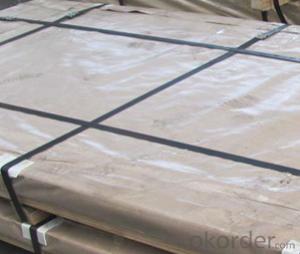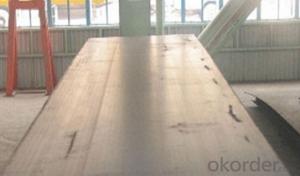Hot Rolled Carbon Steel Sheet A709 CNBM
- Loading Port:
- Qingdao
- Payment Terms:
- TT OR LC
- Min Order Qty:
- 10 pc
- Supply Capability:
- 30 pc/month
OKorder Service Pledge
Quality Product, Order Online Tracking, Timely Delivery
OKorder Financial Service
Credit Rating, Credit Services, Credit Purchasing
You Might Also Like
Quick Details
| Standard: | AISI, ASTM, DIN, GB, JIS | Grade: | A572,A573,A633,A678,A709,A710,G3101,G3136,etc | Thickness: | 1mm-200mm |
| Brand Name: | SHOU GANG GROUP, AN STEEL | Model Number: | Q235 | ||
| Type: | Steel Plate | Technique: | Hot Rolled | Surface Treatment: | Coated |
| Application: | widely | Special Use: | High-strength Steel Plate | Width: | 1000mm-3000mm |
| Length: | 1000mm-12000mm | Price Term: | FOB CIF CFR |
Packaging & Delivery
| Packaging Details: | standard seaworthy export packing or as the request of customers |
| Delivery Detail: | 10 days after deposit or according to customers' quantity |
Specifications
hot rolled carbon steel sheet
1.Thickness:1mm-200mm
2.Length:1000mm-12000mm
3.Width:1000mm-2000mm
hot rolled carbon steel sheet
| Product | HR steel plate prices carbon steel plate prices per kg |
| MOQ | 25 ton |
| Thickness | 1mm-200mm |
| Width | 1000mm-3000mm |
| Length | 1000mm-12000mm |
| Application | widely |
| Standard | AISI,ASTM,BS,DIN,JIS,GB,etc |
| Grade | A572,A573,A633,A678,A709,A710,G3101,G3136,etc |
| Tpye | Steel plate |
| Surfacing | Coated |
| Productive Technology | Hot Rolled & Cold Rolled |
| Port | |
| Payment Terms | L/C,T/T,Western Union,MoneyGram |
| Product Ability | 5000 tons per month |
| Delivery | 10 days after deposit or according to customers' quantity |
| Packing | standard seaworthy export packing or as the request of customers |
- Q:What is the maximum thickness of steel sheets?
- The maximum thickness of steel sheets can vary depending on various factors such as the type of steel, manufacturing process, and application. However, in general, steel sheets can range in thickness from a few millimeters to several centimeters.
- Q:Can the steel sheets be easily engraved or etched?
- Engraving or etching steel sheets is a widely adopted practice across several industries, including automotive, aerospace, and jewelry. It involves employing specialized tools and techniques to craft intricate designs, patterns, or text on the surface of the steel sheets. The hardness and durability of steel make it an ideal material for engraving, as it can withstand the pressure and cutting force necessary for creating detailed engravings. Furthermore, the sleek surface of steel sheets ensures precise and unclouded etching outcomes. Nevertheless, it is crucial to acknowledge that the ease of engraving or etching may vary depending on the specific type and grade of steel employed.
- Q:Are steel sheets affected by UV radiation?
- Yes, steel sheets can be affected by UV radiation. Exposure to UV radiation can cause the steel sheets to undergo a process called photo-oxidation, leading to the formation of a surface layer of rust or corrosion. To prevent this, protective coatings or finishes are often applied to steel sheets to shield them from UV radiation and minimize its impact.
- Q:Can steel sheets be used in architectural or decorative applications?
- Yes, steel sheets can definitely be used in architectural or decorative applications. Steel is a versatile and durable material that offers numerous benefits for both structural and aesthetic purposes. In architectural applications, steel sheets can be used for roofing, wall cladding, and structural framing, providing strength, stability, and resistance to harsh weather conditions. Additionally, steel sheets can be fabricated into various shapes, sizes, and finishes, allowing architects and designers to create unique and visually appealing structures. In decorative applications, steel sheets can be used for interior and exterior design elements such as decorative panels, screens, railings, and sculptures. The ability to customize steel sheets with various patterns, textures, and colors makes them a popular choice for enhancing the visual appeal of buildings and spaces. Overall, steel sheets are a versatile material that can be utilized in a wide range of architectural and decorative applications, offering both functionality and aesthetics.
- Q:What is the average cost of stainless steel sheets?
- The average cost of stainless steel sheets can vary depending on factors such as size, thickness, grade, and market conditions. However, as of 2021, the average cost ranges from $30 to $150 per square foot.
- Q:What is the difference between a hot rolled and cold rolled galvanized steel sheet?
- The manufacturing process and resulting properties of a galvanized steel sheet differ between hot rolled and cold rolled. Hot rolled sheets are created by heating a large steel slab or billet above its recrystallization temperature, usually around 1700°F (926°C). This high temperature allows for easy shaping and forming of the steel into the desired thickness and dimensions. It also refines the grain structure and produces improved mechanical properties and a more uniform distribution of alloying elements. On the other hand, cold rolled sheets are manufactured at room temperature by passing the hot rolled sheet through rollers that compress and shape the material. This reduces the thickness of the sheet, increases its tensile strength, and improves its surface finish. Cold rolling also allows for tighter tolerances and more precise dimensions, making it suitable for applications that require high precision and consistency. In terms of properties, hot rolled sheets have a rougher surface finish due to the high temperature processing. However, they are generally more ductile and easier to form or bend compared to cold rolled sheets. Hot rolled sheets also have a slightly thicker oxide layer on the surface, providing additional corrosion resistance. On the other hand, cold rolled sheets have a smoother and more polished surface finish. They are typically thinner and have a higher strength-to-weight ratio compared to hot rolled sheets. The cold rolling process also results in a more homogeneous microstructure, improving the overall mechanical properties such as hardness and toughness. Ultimately, the choice between hot rolled and cold rolled galvanized steel sheets depends on the specific requirements of the application. Hot rolled sheets are often preferred for applications that require easy formability and a rougher surface finish, while cold rolled sheets are favored for their higher strength, tighter tolerances, and smoother surface finish.
- Q:What is the difference between a perforated and expanded steel sheet?
- A perforated steel sheet is a flat metal sheet with evenly spaced holes, typically created through a mechanical punching process. On the other hand, an expanded steel sheet is formed by cutting and stretching a solid metal sheet, resulting in a grid-like pattern with diamond-shaped openings. While both provide ventilation, drainage, and visibility, perforated sheets offer more precise hole patterns and sizes, making them suitable for applications that require specific hole arrangements. Expanded sheets, on the other hand, provide a more rigid structure, making them ideal for walkways, catwalks, and platforms.
- Q:What are the different sizes of steel sheets available?
- The different sizes of steel sheets available can vary depending on the specific manufacturer and supplier. Common sizes include 4x8 feet, 4x10 feet, and 5x10 feet, but there are also custom sizes available to meet specific project requirements.
- Q:What's the difference between steel plate 20 and Q235 steel plate?
- 20 is a high-quality carbon structural steel, Q235 is carbon structural steel, and steel 20 is higher than Q235.According to the application of the situation, the two kinds of steel generally in the load is not large, the requirements are not high can be exchanged
- Q:What is the process of applying anti-slip patterns to steel sheets?
- The process of applying anti-slip patterns to steel sheets typically involves embossing or etching the surface of the sheet with raised patterns or textures. This can be done using specialized machinery or through chemical treatments. The patterns are designed to increase friction and traction, making the steel sheet less slippery and safer to walk on.
1. Manufacturer Overview |
|
|---|---|
| Location | |
| Year Established | |
| Annual Output Value | |
| Main Markets | |
| Company Certifications | |
2. Manufacturer Certificates |
|
|---|---|
| a) Certification Name | |
| Range | |
| Reference | |
| Validity Period | |
3. Manufacturer Capability |
|
|---|---|
| a)Trade Capacity | |
| Nearest Port | |
| Export Percentage | |
| No.of Employees in Trade Department | |
| Language Spoken: | |
| b)Factory Information | |
| Factory Size: | |
| No. of Production Lines | |
| Contract Manufacturing | |
| Product Price Range | |
Send your message to us
Hot Rolled Carbon Steel Sheet A709 CNBM
- Loading Port:
- Qingdao
- Payment Terms:
- TT OR LC
- Min Order Qty:
- 10 pc
- Supply Capability:
- 30 pc/month
OKorder Service Pledge
Quality Product, Order Online Tracking, Timely Delivery
OKorder Financial Service
Credit Rating, Credit Services, Credit Purchasing
Similar products
New products
Hot products
Related keywords





























